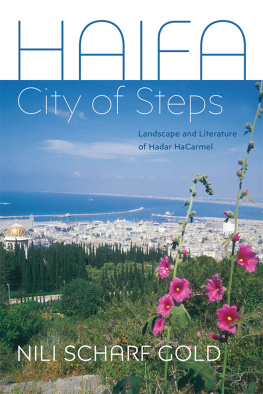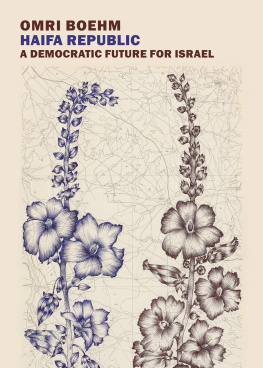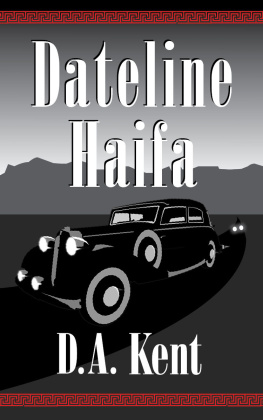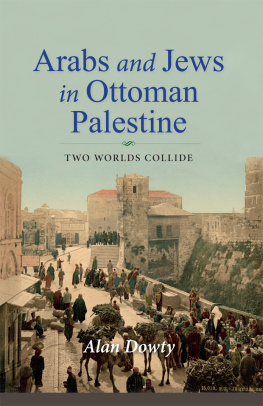
ACKNOWLEDGMENTS
It takes a town to write a book about one. As I embarked on this book about my hometown of Haifa and walked through its streets, I did not walk alone. With me were writers, architects, friends, and colleagues.
The author Amir Gutfreund was born in Hadar HaCarmel in 1963 and died in the prime of his life in 2015. In October 2010 he traveled from his home in the Galilee to the Carmel to meet with me. Haifa awakens the muse in me, he said. In Haifa, the background noises are quiet... but if you want to write a convincing Haifa story, youd better be from Haifa. While his novels fall outside the framework of my book, his spirit hovers over itas too does the soul of Emil Habibi, the quintessential Haifa man. His landscapes, which are so dear to my heart, also fall outside the parameters of this book. Yet the words he wanted carved on his gravestone, I stayed in Haifa, accompany me, one who did not stay.
While I wrote, two books of a different nature were always by my side. Bauhaus on the Carmel and the Crossroads of Empire: Architecture and Planning in Haifa during the British Mandate, published by Gilbert Herbert and Silvina Sosnovsky in 1993, reconstructs, deed by deed, the almost legendary acts of creation wrought by courageous architects on a stubborn land: planning the city of Haifa and making it a capital of modernism. Hayim Aharonovitchs Hadar HaCarmel: A Treatise of Labor and a Creation of a Generation of Founders and Builders appeared thirty-five years earlier. It strings together detail after detail, like beads on a long threaddemographic data, prices of lots, and sewer canalsthat sing an ode in prose to Hadar HaCarmel and its builders.

Many people generously gave of their time, ideas, and heart. Im grateful to each and every one.
There were those who provided invaluable information and documentation: My friend, the architect Waleed Karkabi, head of the Department of Conservation in Haifa, whose love for the city and its buildings was my inspiration from the very first walking tour that I took with him. An overflowing fount of knowledge about architecture and architects in the city, Waleed also opened doors to locked-up archives for me. Eli Roman, a brother in his love of Haifa, sat with me countless hours in his law office, hours that spanned many years and thousands of postcards and documents. Throughout my research and writing, he worked to answer my every question, remove every stumbling block from my path, and introduce me to experts to answer lingering questions. My architectural guide, research assistant, and photographer, architect Adi Silberstein, whose familys roots are in Haifa, gathered for me countless books, articles, and archival documents on the citys structures. Together we walked the route of the book, as she taught me expertly and sensitively how to read a buildings design and to appreciate how an architects creation affects those who use it. Amira Kehat, the ultimate documentarian, has mapped the chronicles of Haifas houses. She and the Haifa History Society opened the gates of their treasure troves for me.
Particularly meaningful were the walks on which fellow Haifaians took me as they revealed their Haifa. Itamar Shoshan, my high school deskmate with whom I explored every nook and cranny of our old school building and yards, related personal memories and gave me his photographs. The former head of city planning, Havah Law-Yone, who coincidentally grew up on my block, guided me through Memorial Park and Herzl Street and taught me the architectural cadences of Hadar HaCarmel. Yovi Sabo nostalgically recounted our childhood as we climbed Haneviim Steps Street together, and he even photographed the neighborhood for this book. Nitza Sabo, his wife, recollected her familys legacy in Hadar HaCarmel as well as her relationship with the poet Dahlia Ravikovitch, who babysat for her. Yovi and Nitza Sabo, like my beloved friends Yosi and Nitza Ben-Dov, hosted me in Haifa and reminded me that even after the intervening decades, Haifa is still home. My cherished colleague and dear friend Nitza Ben-Dov lovingly supported this project from its inception. Yosi, as the executive director of the Hebrew Reali School, gave me a tour of the historical school building and arranged access to its records and rich archives.
My esteemed colleague Yossi Ben-Artzi offered sage advice and kindly made available his huge vaults of books and materials; he and his wife, Orit, cheered me on throughout. The architect Ziva Kolodney, head of Long-Term Municipal Planning in Haifa, expounded on her fascinating work on landscape architecture. Edina Meyer-Maril shared her writings on and intimate knowledge of Alexander Baerwald. Giddon Ticotsky let me in on his discoveries about Dahlia Ravikovitch without reservation. Alon Tam contributed his expertise in Arabic and the region; Regev Nathansohn shared his meticulous documentation and research.
This is the second book on which Julia Holleman has worked with me. Her unwavering integrity, her rare gifts of writing and editing, and her elegant style are interlaced throughout these pages. Julias identification with my life story and dedication to this intellectual journey motivated me to complete this endeavor. Yuval Moses worked with me on the earliest iteration of the book, in Hebrew. His wisdom and ability to see the essence of things were a driving force at that crucial stage.
The midwife of the book was, without a doubt, Sylvia Fuks Fried, director of Brandeis University Press and my much admired editor and friend, who listened intently and held my hand. With endless tact, she made wise comments to improve the text and enabled me to continue, chapter after chapter. Phyllis Deutsch, editor in chief at University Press of New England, believed in this book from the start and guided it with her keen eye. I also want to thank professors Jehuda Reinharz, Dan Ben-Amos, Yigal Schwartz, and Roger Allen, all of whom read various drafts of the manuscript and made valuable comments. Jessica Kasmer-Jacobs, Jonah Wilkof, and Hannah Spivak helped polish and improve the final product.
One of the pillars on which this book stands are literary works on Haifa. Some of their authors graciously granted me interviews. I am eternally grateful for the time, openness, and inspiration of Esty G. Hayim, Yehudit Katzir, Sami Michael, A. B. Yehoshua, and the late Yehudit Hendel; and for the kindness of Natan Zach and his translator, Vivian Eden.
I want to thank my academic home, the University of Pennsylvania; my colleagues in the department of Near Eastern Languages and Civilizations and especially its chair, Paul Cobb, for his enthusiastic support; Arthur Kiron, curator of Judaica Collections, who encouraged me and who left no stone unturned until he obtained the bibliographic materials I needed; and Sheila Ketchum and Jasmine Shinohara at the Van Pelt Library. I am grateful to the Jewish Studies Program for its support through the Littauer Faculty Research Fund, which made possible the contribution of the talented artist Katherine Messenger. Thanks to her exquisite hand-drawn maps, the path of this book can be followed visually. Thanks also to the Schusterman Center for Israel Studies at Brandeis University for its publication grant.
I am grateful to the architect Amir Tomashov, who advised me and introduced me to the architectural community; Nisim Levi (Nassuma), whose memories and memoir capture the Talpiot Market; Michal Henkin and Adam Prager from Haifa City Archive; Natan Kundinsky, historian of Magen David Adom; Amikam Yasur, the star bibliographer who paved the way for my initial research; Moshe Gerstel, cinematographer and the grandson of the great architect; Michael Levin, the art and architectural historian. The Dresner family; Gabriel Laufer, my classmate and amateur photographer; Sara Klai, my classmate; Zvi Roger, the municipal photographer and fellow Scout; Dahlia Levi Eliahu, heiress to Eliahu Bros. Postcards; and Yeri Rimon, the ultimate collector of everything Haifa, all shared their precious photographs and memories with me. My treasured and oldest friend, Rivka Hadar, filled in many blanks about our years in the Scouts.
Next page
















